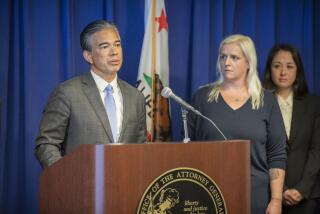Longtime Friends Forge Another Link: Adoption
- Share via
From the moment she saw the ultrasound -- the black-and white images of the twin girls in her womb -- Anese Adams knew she wanted the babies to be adopted by her best friend.
Cynthia Rice had been godmother to Adams’ two older children, but the window to bear a child of her own was narrowing. Nearly 38, she’d already had one miscarriage. Her reproductive system was scarred by fibroid tumors, leaving her to struggle with the idea that “this might not be my destiny.”
So Adams made a decision: These would be Rice’s children.
“Cynthia is my rock,” said Adams, 36. “We are sisters without the blood. ... And this is something I could do.”
After the friends agreed on this course, their resolve did not waver -- even when doctors said one of the fetuses had developed profound health problems and might be born with Down syndrome.
So it was that the bonds of friendship and motherhood brought Adams and Rice to the delivery room of Rush University Medical Center on a chilly day in May.
Adams -- who was on the operating table, undergoing a Cesarean section -- had been the mother of these girls for the past 35 weeks. Rice, hovering in surgical scrubs, would be their mom for the rest of their lives.
Three days earlier, the friends sat in a booth at a pancake house, recalling the moment the idea came up, not long after the ultrasound in December. They swear it bubbled up spontaneously and simultaneously.
“My first reaction was to ask Anese: ‘Can I have those?’ ” said Rice. “But ... who does that?”
Adams interjected: “I said, ‘Are you serious?’ ”
Rice: “Then I said, ‘Are you for real?’ ”
By this time, they were both collapsing into laughter, just as when they were teens.
*
If precise words elude them in describing their arrangement, perhaps that’s because it is easier to explain what it is not.
The women are not lesbian partners. (Adams is separated from her husband; Rice is unmarried.) Nor is this a surrogacy, where a woman is hired to bear an infant. (“Someone asked me if I was getting paid, and I was really offended,” Adams said.) Neither woman has a relationship with the father, who has legally consented to the adoption, according to Rice’s lawyer, Sara R. Howard.
Adams has signed irrevocable consent, Howard said, and in six months, Rice will finalize the adoption in court.
During the pregnancy, they had endless conversations.
What is Adams’ role? To be the twins’ godmother, just as Rice is to Adams’ children, ages 16 and 7. Who will care for the girls? Rice will take a three-week maternity leave from her job with the Department of Streets and Sanitation. After that, her mother, who lives downstairs, will provide day care.
And what about establishing boundaries?
“It wouldn’t be any different if the babies came from Cynthia’s womb,” said Adams, an executive recruiter who is also a Navy reservist. “I’d still be in their lives, dressing them up and spoiling them, whether I carried them or not.”
Such devotion is rooted in their childhood, when the girls lived on the same block. Rice and her cousins would chase Adams, a self-confessed “nerdy bookworm.” But when Rice’s cousins moved away, the pair became friends. Over the subsequent decades, their shared history grew deeper -- through broken hearts, job woes, the death of a parent.
To these two smart, self-sufficient women with a deep belief in God, some acts just require a leap of faith.
This is one.
“My kids are excited,” Adams said. “Cynthia’s family is excited. Everything will work out.”
*
During their discussions, the question arose: What would happen if something was wrong with the newborns?
By the 19th week of Adams’ pregnancy, the possibility was no longer an abstraction. Something troubling popped up in a test, and Adams was referred to Rush’s new Fetal and Neonatal Medicine Program, which helps expectant parents with high-risk babies navigate the challenges ahead.
Baby B was diagnosed with atrioventricular canal defect. Instead of two heart valves, she has one, explained Dr. Bettina Cuneo, a perinatal cardiologist. At three months of age, the infant would have to undergo open-heart surgery.
More bad news followed: It was likely Baby B had Down syndrome, a chromosomal abnormality with no surgical fix.
The one-two punch left Adams reeling. The one thing she wanted, to deliver two healthy daughters, wasn’t going to happen.
When Adams visited Rice and saw her nesting -- “putting up wallpaper borders in the nursery and hooking a Mickey Mouse rug” -- it gave her a bittersweet feeling.
“I just wanted them to be perfect,” she said, her voice cracking. “I did question myself as a vehicle.”
Adams also feared her friend might change her mind. But Rice said she needn’t have worried: “Why would I not want it? I wouldn’t feel any different if this was my biological child.
“Of course, every mother hopes for a healthy baby,” she added, weighing her words carefully. “But there are some things we just can’t plan. If we could, we’d all have perfect lives.”
Two days later, both women were in a conference room, surrounded by a formidable array of brain power. Some 15 experts -- obstetricians, perinatologists, neonatologists, geneticists, ethicists, social workers -- were there to lay out every option, answer every question. No one billed for their time.
“When parents walk in, they see a lot of sincere people whose only goal is to reassure them,” said Dr. Jacques Abramowicz, co-director of the program. “When they leave, the difference in their anxiety is like night and day.”
That doesn’t mean it’s easy. For the first time, the two moms heard the words “selective termination” -- which they say they never considered, even in the darkest moments. They even declined amniocentesis, which would have confirmed the Down’s diagnosis.
As in everything else, they were steadfast, agreeing: We do not give life; we have no right to take it away.
*
Belly swollen, Adams arrived at Rush with Rice for a routine doctor’s appointment at 3 p.m. on May 4.
Her Cesarean section had been scheduled for May 17. But there would be an abrupt change of plans. As Rice waited in the hall, a shriek came from behind the closed door.
“Four centimeters? Four centimeters? I’m not ready.”
But the sisters, who were in the breech position, facing each other, “playing patty cake,” were very ready.
Adams had a history of quick delivery, so she and Rice -- uttering, “Oh my God, oh my God” -- were dispatched to labor and delivery immediately.
Adams’ thoughts were racing. The twins could not arrive on this day: She needed to take her mother to the doctor, attend her 7-year-old’s school performance, pack her hospital bag -- which, at this point, contained only a pair of socks.
At 5:15 p.m. Adams, dilated two more centimeters, was wheeled into the operating room, Rice right behind her. The surgeon made an incision across Adams’ abdomen, and within minutes a foot emerged, followed by a prune-like being who gave a lusty cry before being whisked away by a cadre of nurses.
“Come here, Mom. Do you want to cut the cord?” the neonatologist, Dr. Jean Silvestri, said to Rice, whose eyes were glistening. It was a lump-in-the-throat moment for the team too.
“This happens to each and every one of us, each and every time,” said Maria Reyes, a perinatal nurse practitioner and the program’s clinical coordinator. “We are breathless with amazement at the beauty of birth.”
The clock ticked to 6:05, barely three hours after they had arrived for the appointment. Rice named her first-born daughter Peyton Noelle, who tipped the scales at 4.1 pounds.
Baby B weighed 2 ounces more. Her name is Phoenix -- because of the challenges she will face -- Isryelle.
The baby did not look as if she had Down syndrome, but the physical signs often are not present at birth. Only when the chromosomal tests came back would medical staff know for sure.
But in this moment, everyone in the room was celebrating.
“It’s very important to treat them both as mothers -- which was our goal from the beginning,” Reyes said. “We wanted to make this a shared experience, because, when it’s all said and done, there’s more than enough love to go around.”
*
With emotions and hormones running high, perhaps it’s not surprising that the transition period was a bit tricky.
Three days after the birth and one week before Mother’s Day, both Adams and little Peyton were cleared to leave the hospital. (Phoenix must remain until she is stronger.)
Adams had hoped to stay at Rice’s home that first night.
But Rice had decided she wanted to be alone on her first night with her new daughter, to deal with the whole glorious, scary, sleepless experience on her own. That left Adams feeling marginalized.
“I don’t have any regrets,” Adams said. “I just thought I’d have more time.”
Then, on May 11, the Down’s diagnosis was confirmed. Rice said she had no regrets, either; her desire to be a mother trumped any uncertainty about the road ahead.
“It doesn’t change anything. ... I said that we’d get through it and I still feel that way,” Rice said.
Both will continue to find strength where they always have: in faith and friendship.
More to Read
Sign up for Essential California
The most important California stories and recommendations in your inbox every morning.
You may occasionally receive promotional content from the Los Angeles Times.










